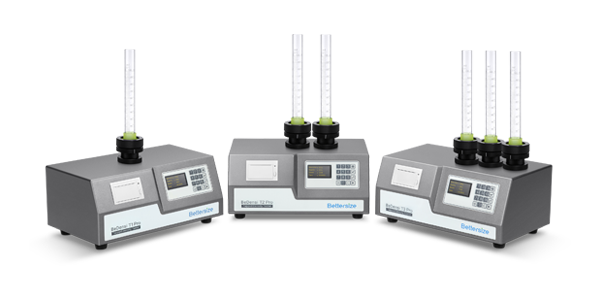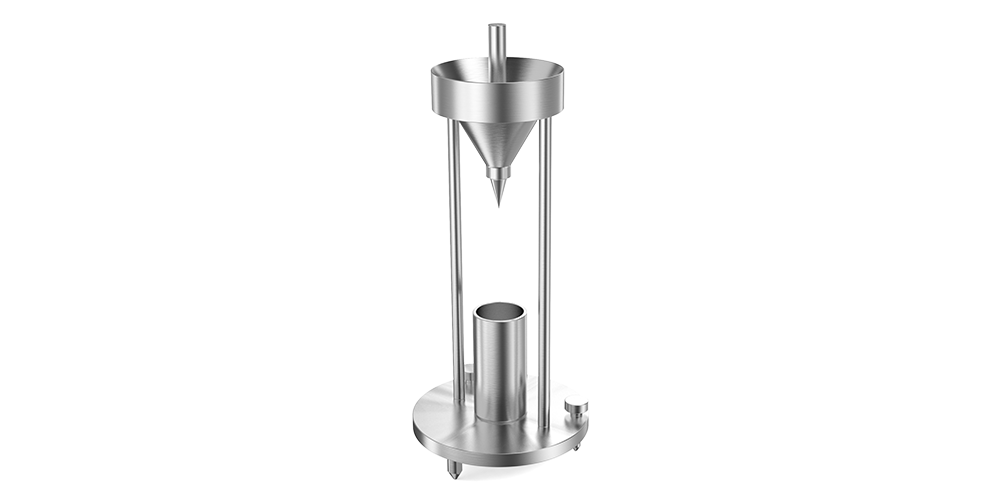Mining and Minerals
Instruments provided by Bettersize are widely used in the research, manufacturing and application of all kinds of mining and minerals, bringing favorable profits.
The Bettersize's particle size and shape analyzer and powder characteristics tester can provide complete physical property analysis and granulometry analysis for the deep processing of mining and minerals, and offer data, including particle size distribution, particle shape, flowability, tap density, and bulk density, helping you to reduce the cost of mineral processing and control the correct particle grades of products.
Abrasives, fluorspar, gallium, mica, soda ash, antimony, garnet, molybdenum, arsenic, nickel, strontium, asbestos, germanium, niobium, sulfur, barite, gold, talc, bauxite, graphite, tantalum, beryllium, gypsum, perlite, tellurium, bismuth, hafnium, phosphate rock, thallium, boron, platinum, thorium, bromine, indium, potash, tin, cadmium, iodine, pumice, titanium, cement, iron and steel, quartz crystal, tungsten, cesium, iron ore, rare earths, vanadium, chromium, iron oxide pigments, rhenium, vermiculite, clays, kyanite, rubidium, wollastonite, cobalt, lead, yttrium, copper, lime, sand, zeolites, diamond, lithium, scandium, zinc, diatomite, magnesium, selenium, zirconium, feldspar, manganese, and silicon are all materials that are mined and then extracted from the ore. If it is mined, particle size distribution measurement in the extraction of useful minerals is an arduous and technically demanding. The ore is blasted or cut, and then loaded and hauled to the mill for the secondary crushing and grinding, which prepares the material for its intended use.
Comminution
In many cases, the valuable minerals are mixed with gangue, and the ore must be separated. The first step of many separation processes is comminution (size reduction), followed by classification (separation by particle size) either for further grinding or the next step, concentration of the ore. During comminution, ore must be ground such that the particles are small enough that each particle consists of primarily one mineral. These particles are then separated to concentrate the mineral product.
Gravity Separation
Gravity separation relies on differences in material mass to separate minerals. Methods include jigs, sluices, spirals, shaking tables, fine particle separators, and hydrosizers and cyclones. Gravity separation is separation based on weight only and is directly affected by particle size since volume is proportional to weight.
Jigging uses pulsed water flow or a similar process to push up ground material. Heavier and larger particles will sink more quickly between pulses and thus tend to the bottom of the jig. Thus, uniform particle size is important to ensure separation by density instead of size. In addition, jig operation (length of water pulses) and design will depend on the size of particles being separated. Sluices and spirals rely on the difference between viscous drag and buoyancy for particle separation. This difference is directly related to particle size. Gravity tables use a vibrating platform to separate by particle size and specific gravity. Thus, narrow size distribution feeds result in better separation.
Froth Flotation
Here the material is separated by surface chemistry. Bubbles flowing through a slurry or suspension will tend to stick to particles with a hydrophobic surface and cause the particles to float to the top of a froth for recovery. Often, particle surfaces are selectively modified so that mineral surfaces are hydrophobic while gangue surfaces are hydrophilic. Particle size is important to the process efficiency. Overly fine particles may be entrained in the bubble flow regardless of surface chemistry, reducing the effectiveness of separation efficiency. Overly large particles will tend to sink regardless of bubble attachment.
Electrostatic and Magnetic Separation
The behavior of a particle under electrostatic or magnetic fields can be exploited to separate particles by type. These fields will induce charges (or magnetism). The resulting forces will cause particles to move depending on particle mass. Thus, small particles are moved further than large particles. Furthermore, particle charge is a surface phenomenon, and the larger surface area of fine particles will tend to have a higher charge. These size effects can lead to separation by size rather than composition. As such, a narrow size distribution often, but not always leads to better separation.
Shipping Product
The final product is often graded and sold as-is or for further processing. Users will want a particular particle size range in order to ensure that their process is optimized. Thus, in the all-important step of selling products, many mines will control particle size and in some cases, particle shape is important as well.
The particle sizing systems below are fully capable of measuring size and shape to assist the user to obtaining the optimal size throughout the manufacturing process.
Citations
- Bettersizer 2600
Functional redundancy as an indicator for evaluating functional diversity of macrobenthos under the mussel raft farm near Gouqi Island
DOI: 10.1016/j.aquaculture.2023.740024 Read ArticleZhejiang Ocean University | 2024Biological traits analysis (BTA) helps to evaluate the effects of different environmental variables on the traits-based functional composition of macrobenthos. However, research on functional traits of macrobenthos under mussel farming is limited. We investigated the spatial and temporal response of the benthic system in terms of taxonomic and functional diversity to environmental variables of farming and natural stressors resulting from suspended mussel farming near Gouqi Island of eastern China Sea. The functional traits of macrobenthic assemblages under mussel farming were characterized by “medium adult body size”, “vermiform body form”, “high flexibility”, “infauna”, “semi-motile”, “gonochoristic”, “surface deposit-feeders”, “carnivores”, “semi-motile burrowers”, and “tube-dwellers”. Functional redundancy was stable in response to mussel farming stresses among seasons, whereas species diversity showed efficient to evaluate natural variables. Functional diversity was significantly affected by farming stressors rather than natural variables, Further analysis using multivariate methods together with continuous monitoring were highlighted to evaluate the impacts of mussel farming. Our results reinforce the importance of macrobenthic species and functional traits analysis to evaluate human stresses driven impacts in offshore ecosystems. By analysing the environmental variables with different sources, independently, we concluded the main effects of human pressures on macrobenthic community. Such distinction could be particularly effective to isolate variable environmental descriptors and evaluate their effects on functional diversity, making the current approach promising for the evaluation of ecological effects of anthropogenic stressors in aquaculture areas. - Bettersizer 2600
Degradation characteristics and utilization strategies of a covalent bonded resin-based solid amine during capturing CO2 from flue gas
DOI: 10.1016/j.seppur.2023.125621 Read ArticleChina University of Petroleum | 2024In this study, various types of degradation as well as attrition which are possibly encountered in a circulating fluidized bed temperature swing adsorption (CFB-TSA) process, were conducted experimentally to evaluate the stability of a resin-based solid amine sorbent. Other characterizations methods, such as elemental analysis (EA), Fourier transform infrared spectroscopy (FTIR) etc. were applied to further reveal the degradation mechanisms. The results showed that thermal degradation occurs from 140–160 °C due to the decomposition of amine group. The CO2-induced degradation occurs from a higher temperature of 160–180 °C accompanied by the production of urea. Hydrothermal stability is good below 130 °C, but the ionic impurities in steam crystalized on particle surface can accelerate the degradation. Oxidative degradation is the most harmful, which starts at a lower temperature of 70–80 °C with the formation of aldehyde. The existence of H2O in atmosphere can alleviate the oxidative and CO2-induced degradations. The employed sorbent has a very low attrition index of 0.05, which is 1–2 orders lower than typical commercial fluidized bed catalysts. Based on the results of stability evaluation, some design suggestions for proper utilization of this sorbent or other similar resin-based sorbents have been provided in an industrial CFB-TSA process.
- Bettersizer 2600
De-branching of starch molecules enhanced the complexation with chitosan and its potential utilization for delivering hydrophobic compounds
DOI: 10.1016/j.foodhyd.2023.109498 Read ArticleShihezi University | 2024The current study aimed to prepare the complexes between debranched-waxy corn starch and chitosan polymers (DBS-CS), and then investigated their corresponding structural characteristics, rheological property and potent application in Pickering emulsion. The results indicated that the existence of chitosan significantly inhibited starch short-range molecular rearrangement for all DBS-CS samples, which was manipulated by both debranching treatment and chitosan content. Interestingly, this is the first study to reveal that the outstanding peak at 1.8 ppm in 1H NMR spectrum for sample DBS-CS was gradually shifted towards a lower-field region following an increased chitosan content. Moreover, the debranching treatment shifted the crystallinity pattern from A-type to B-type and the relative crystallinity of DBS-CS decreased gradually with the increased content of CS. All samples had a pseudoplastic fluid and shear-thinning behavior with an enhanced shear resistance following the complexation. The DBS-CS was applied in a Pickering emulsion for showing a greater emulsifying stability and a lower gel strength than native NS-CS prepared emulsion. Importantly, the encapsulation ability of curcumin in the DBS-CS emulsion was significantly improved, followed by an increase of 15.45% for its corresponding bioavailability compared to the control. Therefore, this study might highlight a potential carrier for delivering the bioactive substances in a green pattern. - Bettersizer 2600
Heat-induced aggregation behavior of wheat gluten after adding citrus pectin with different esterification degree
DOI: 10.1016/j.foodhyd.2023.109420 Read ArticleGansu Agricultural University | 2024Wheat gluten aggregation during heat treatment is beneficial to the final quality of gluten-based products. Exogenous pectin can affect gluten aggregation. However, the effect of pectin with different degrees of esterification on the heat-induced aggregation behavior of gluten and its possible mechanism are still unclear. Thus, the heat-induced aggregation behavior of gluten after adding pectin with different esterification degree was studied in this study. When the temperature was raised from 25 °C to 95 °C, pectin affected gluten aggregation and was related to the degree of esterification. Specifically, the results of rheological properties and particle size indicated that low-ester pectin improved the viscoelasticity of gluten and promoted gluten aggregation. Thermal properties revealed that enthalpy of gluten added with low-ester pectin (37%) increased from 92.96 J/g to 95.40 J/g during heating process. Structurally, the fluorescence intensity and surface hydrophobicity of gluten added with low-ester pectin (37%) were lower than those added with high-ester pectin (73%). In addition, low-ester pectin (37%) significantly increased the disulfide bond content (from 15.31 μmol/g to 18.06 μmol/g) and maintained β-sheet content of gluten compared with gluten alone at 95 °C, indicating that low-ester pectin was more likely to induce gluten aggregation. However, scanning electron microscope showed that the gluten added with low-ester pectin (46%) exhibited a denser network structure at 95 °C than that added with low-ester pectin (37%). These results will provide a theoretical base for the regulation of gluten aggregation and the quality of gluten-based products by pectin with different esterification degree.
- 1
- 2
- 3
- 4
- 5
- 6
- 84
Curated Resources
Related Particle Size Analyzer
-
Bettersizer S3 Plus
Particle Size and Shape Analyzer
Measurement range: 0.01 - 3,500μm (Laser System)
Measurement range: 2 - 3,500μm (Image System)
-
Bettersizer 2600
Laser Diffraction Particle Size Analyzer
Measurement range: 0.02 - 2,600μm (Wet)
Measurement range: 0.1 - 2,600μm (Dry)
-
BeVision D2
Dynamic Image Analyzer
Dispersion type: Dry
Measurement range: 30 - 10,000μm
Technology: Dynamic Image Analysis
-
BeVision M1
Automated Static Image Analyzer
Dispersion type: Dry
Measurement range: 1 - 10,000μm
Technology: Automated Static Image Analysis
-
BeVision S1
Classical and Versatile Static Image Analyzer
Dispersion type: Dry & Wet
Measurement range: 1 - 3,000μm
Technology: Static Image Analysis
-
BeDensi T Pro Series
Tapped Density Tester with a Wallet-Friendly Solution
Number of Workstations: 1-3
Tapping Speed: 100 - 300 taps/min
Repeatability: ≤1% variation
-
PowderPro A1
Automatic Powder Characteristics Tester
Operation Mode: Automatic
Tapping Speed: 50 - 300 taps/min
Repeatability: ≤3% variation
-
BeDensi B1
Bulk Density Tester
Measurement: Bulk Density
Compliance with GB/T 16913
-
HFlow 1
Flowmeter Funnel
Measurement: Bulk density and Flow rate
Compliance with USP, Ph. Eur., ASTM, and ISO standards












